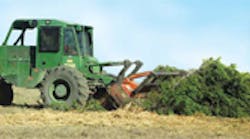Unwanted cedar growth and regrowth have become a problem in parts of Texas. One acre of cedar can consume more than 50,000 gal of water per year. To reduce this waste, many landowners recycle cedar wasteland into productive grassy watershed areas. Using a dozer to clear cedar may do more harm than good because cedar berries germinate after they get scattered across the ground. The result is regrowth of the cedar.
To fight this battle, Stan Hegener started Cedar Eaters of Texas, Bergheim. Its fleet consists of four tractors, all equipped with a hydraulically powered Bull Hog BH120 shredder head from Fecon Inc., Lebanon, Ohio. The Cedar Eater reduces cedar mesquite trees and underbrush to mulch, which holds soil in place during rain, preventing erosion and creating ground cover. No stumps are left behind, no burning or hauling is needed, and the soil isn’t disturbed.
Can’t take the heat
Daytime temperatures exceeding 105° F are not uncommon in a Texas summer. Such temperatures can cripple equipment productivity, especially if general-purpose hydraulic fluids are used. If high temperatures thin out a hydraulic oil, its lower viscosity decreases volumetric efficiency of components.
During hot months, Hegener noticed his equipment continually lost power and hydraulic capabilities so he knew he had to switch his hydraulic fluid. “The old fluid just seemed to thin down, which resulted in power failure,” explains Hegener. “And drain intervals were short. It was recommended that we change the fluid every 1000 hr.”
Hegener’s equipment dealer, Lynn Hendrix, recommended he switch to Petro-Canada’s Hydrex XV through a local distributor, Steagall Oil Co. Hydrex XV is a long-life, anti-wear hydraulic fluid for all-season use. It provides operating and maintenance benefits for higher productivity in very hot or cold temperatures — exactly what the Cedar Eaters needed.
Adding new life
“After switching to Hydrex XV, we hoped to extend our drains to 2000 hr,” Hegener said. “That would mean buying much less hydraulic oil and less labor and downtime to change it, consequently leading to big savings.”
An oil analysis program showed the oil could last longer than this, however. “We took a look at the fluid in one of our machines after 2000 hr and it still looked clean so we sent it in for analysis. It came back with great results, so we were advised to keep using it,” Hegener said. “We sent it in at 3000 and 4000 hr, and the results were still great. Now we’re at 4500 hr.”
Hydrex XV is versatile in all temperatures. Texas winters get chilly — it’s often around 30° F. This doesn’t impact the Cedar Eater’s hydraulic oil, which operates in temperatures from –40° to 167° F. This means shorter warm-up time on cold days, faster, smoother response for hydraulic systems, and extra wear protection during extreme high temperatures.
Hydrex XV is free of most impurities found in conventional oils. The fluid starts with a patented high-purity process that produces 99.9% pure base oils. By removing impurities that can hinder oil performance, it retains its ‘fresh oil’ properties longer. Petro-Canada then blends these clear base oils with additives to provide allseason performance, high oxidation and thermal stability, anti-wear protection, and water separability with improved foam and air entrainment performance.
For information, call (888) 284- 4572 or visit www.petro-canada.com. For information on Cedar Eaters, visit www.cedareater.com.


